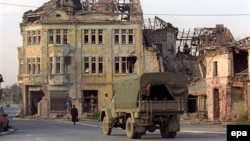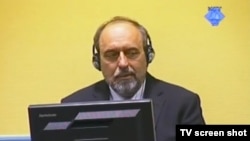In reaction to my blog post on Goran Hadzic, who died before the case against him at the International War Crimes Tribunal was completed, I received an e-mail from a well-respected U.S. historian. In a courteous and otherwise supportive message, the professor objected to my description of the level of devastation of Vukovar in 1991, at the outset of the Yugoslav wars:
"I want to correct a misstatement in the text that has become an urban myth in the annals of the Yugoslav wars: Having visited Vukovar shortly after the conclusion of hostilities and several times since, I can assure you that the city was far from 'totally destroyed'.To be more precise, only the relatively small downtown area was devastated. Although there was significant damage to outlying structures that were targeted by JNA [Yugoslav People's Army] artillery (every non-Orthodox church, the train station, the Eltz palace/museum, the water tower, among many others), most of the rest of the town was surprisingly intact. Vukovar residents themselves have been quick to point this out to visitors," the professor wrote.
Not every building in Vukovar was leveled to the ground. In that respect the professor is right. Parts of the city inhabited predominantly by Serbs were largely spared. But there can be no doubt that the scale of the destruction was staggering, and that it was fairly comprehensive. The center of Vukovar, its landmarks and emblematic baroque buildings were destroyed. The extent of the damage may be seen in this photo gallery:
PHOTO GALLERY: War Takes Its Toll On Vukovar
But the city was also destroyed in another sense -- its social fabric was rent asunder. One of the most diverse and multiethnic communities in the former Yugoslavia was extinguished completely as such. Even after the material damage has been repaired, Vukovar is no longer the same city. The formerly cosmopolitan spirit of Vukovar -- which belied the city's modest size -- was irreversibly destroyed.
Reduced To Ashes
Before the war, more than 20 ethnic groups lived in Vukovar. Not only Serbs and Croats, who made up the majority, and those who identified as "Yugoslavs" (roughly 10 percent), but also Ruthenians/Rusyns, Hungarians, Ukrainians, and many others. Moreover, the citizens of Vukovar were proud of their multicultural city, and ethnic background was irrelevant in daily life and social relations.
All of that was reduced to ashes after 87 days under siege and incessant bombardment by the Yugoslav People's Army and paramilitary groups from Serbia. Carol Williams of the Los Angeles Times described the devastation after the fall of the city, in November 1991:
"Not a single home is habitable. No shop, no church, no public building survived. The rubber factory that provided jobs for the former city of 60,000 is a mass of twisted metal, crumbled brick and cratered earth. […] the city is a wasteland, devastated beyond repair. The only hope for a new Vukovar is bulldozing the ruins and rebuilding from scratch…"
Today Vukovar has been rebuilt, but the tension and mutual suspicion remain. The Croatian government's recent attempt to introduce signs in both the Latin and Cyrillic alphabets (used by Croats and Serbs, respectively), was met with mass protests organized by those who claim to stand for a "Croatian Vukovar." The city has become a symbol of the Homeland War -- Croatia's war of independence from Yugoslavia -- and has been heavily exploited by Croatian nationalists as "Croatia's Stalingrad, the martyred city."
Connecting The Dots
Only after the war was I able to connect the dots between Vukovar, Dubrovnik, Sarajevo, and Mostar. What connects these cities, two in Croatia and the other two in Bosnia, is the fact that they were arguably the most successful multiethnic communities in the former Yugoslavia, true melting-pots of Balkan nations.
People in all four cities did not merely tolerate one another, they actively embraced each other's culture and ways. This was not just the result of the official ideology of "brotherhood and unity" proclaimed by the late president Tito, or some communist imposition. That way of life and cultural exchange was older than Tito. It was result of a troubled history. To protect one's neighbor was a survival strategy through successive occupations and liberations, the rise and fall of empires in the Balkans.
So that old "look-after-your-neighbor" culture, especially if your neighbor is of a different ethnic group, was the first casualty of war.
People like Goran Hadzic believed that they were performing a service for their nation by destroying the bases of common life, and eliminating the "other."
That is why I feel it's impossible to overstate the level and the nature of the destruction of Vukovar. Cities and communities do rise from the ashes, and I would settle for speaking of the "destruction" of Vukovar, rather than its "total destruction". But regardless of how we designate Vukovar's tragedy, there can be no doubt that Europe watched it happen, and did nothing.
In Vukovar, and later in Bosnia, Europe missed a chance to properly articulate and defend its core values -- tolerance, multiculturalism, civil society, peace, freedom, and democracy -- and chose not to stand up to violent ethnic nationalism, to those who propagated fear and hatred of the other.
















